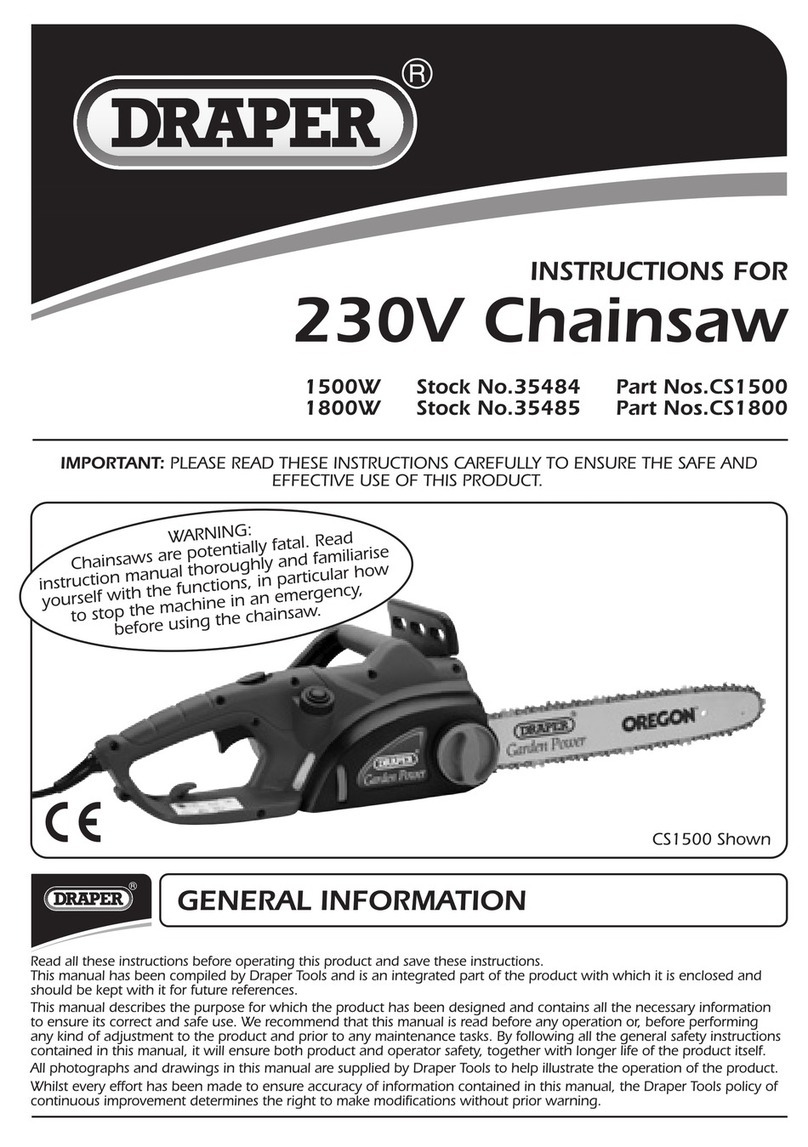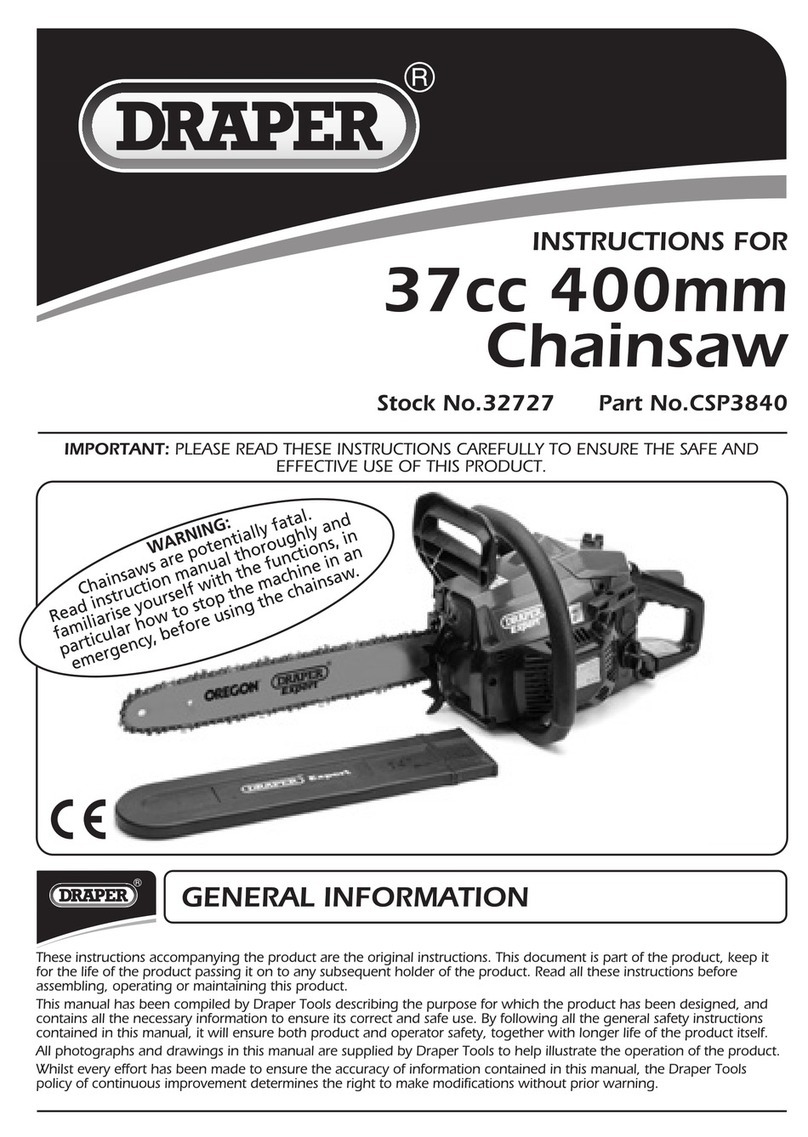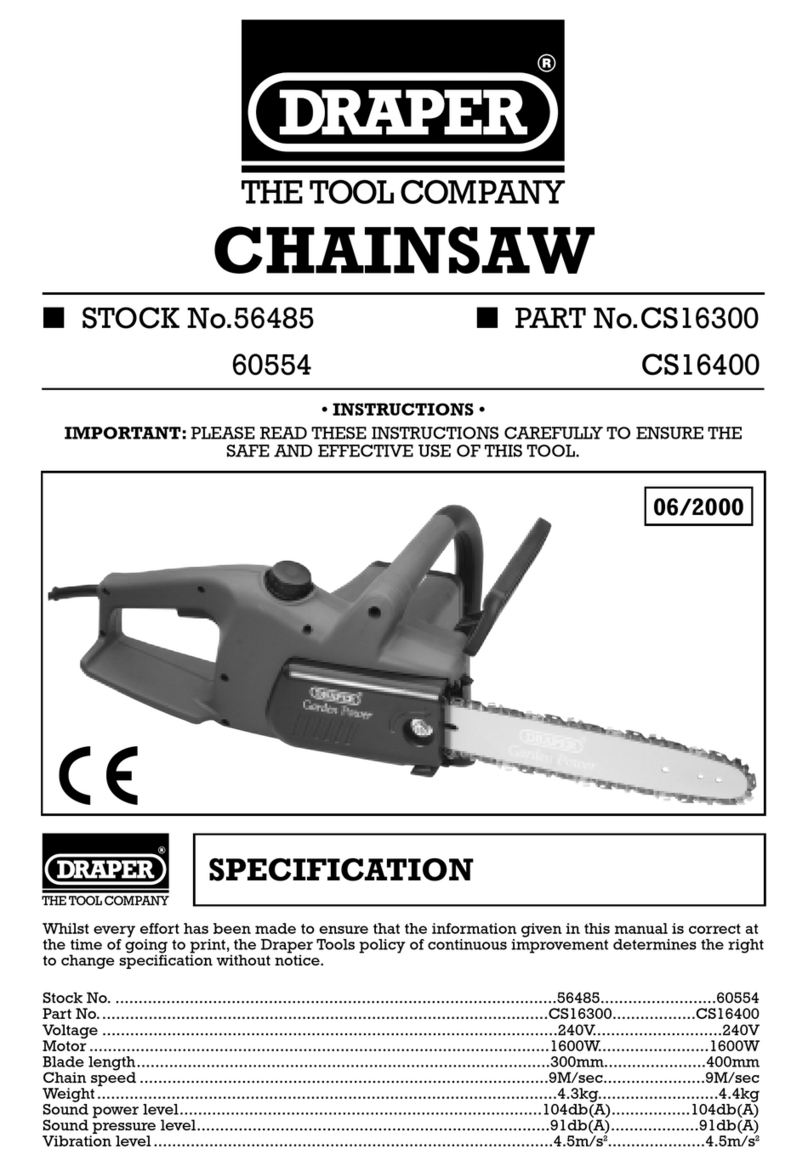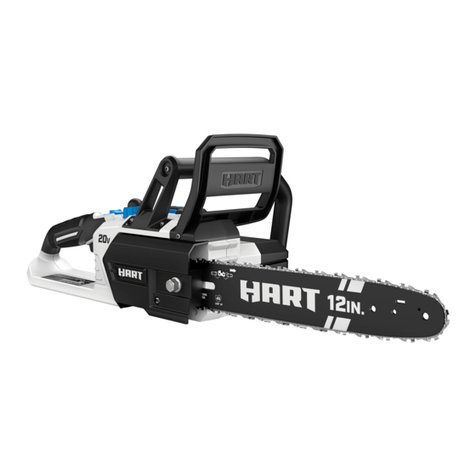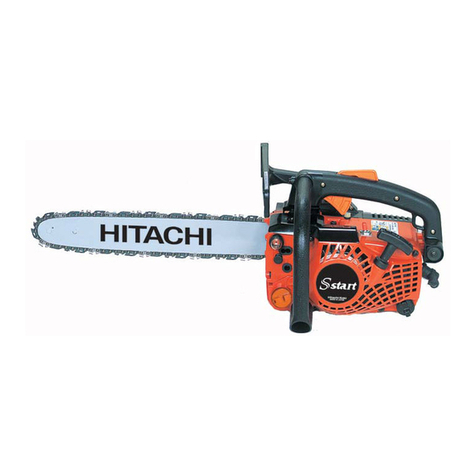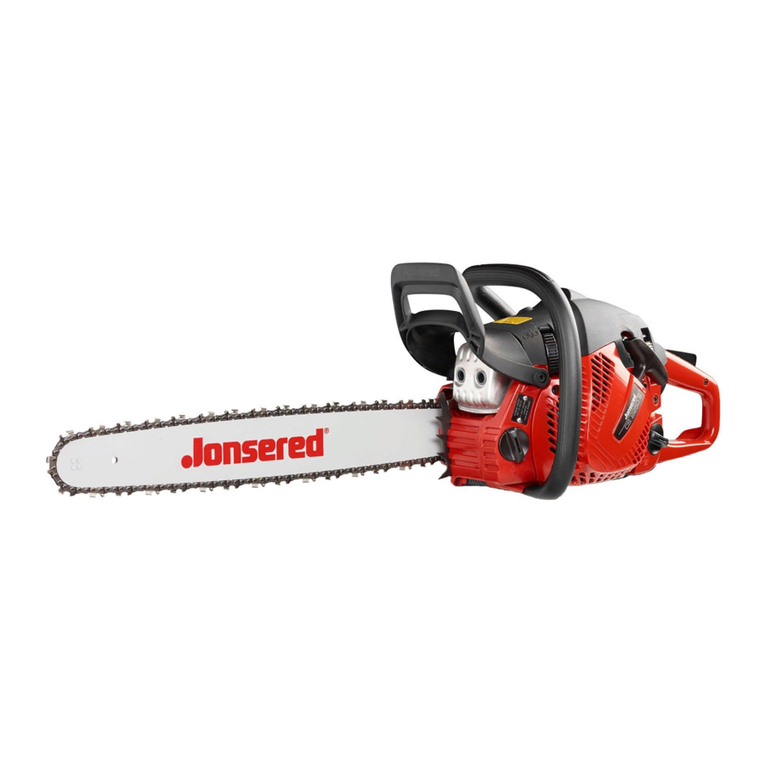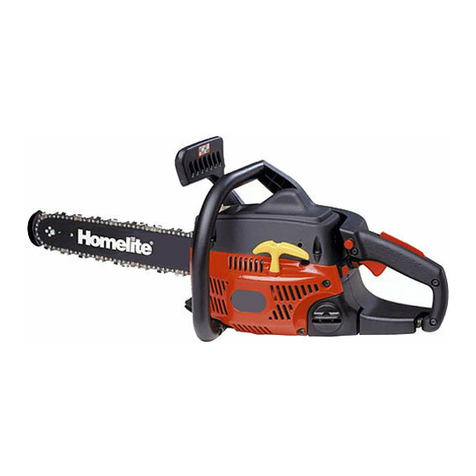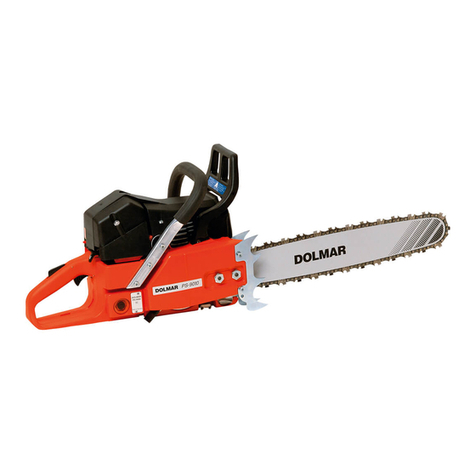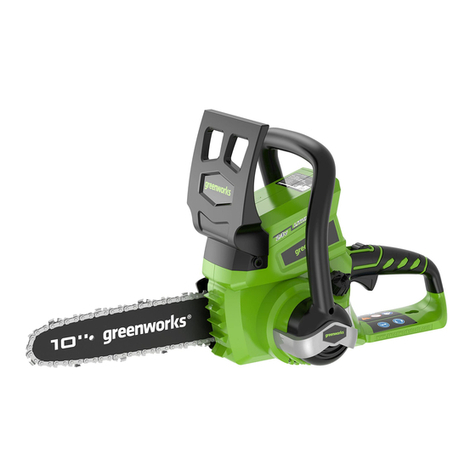Draper CSP45450 User manual

CONTACTS
- DRAPER TOOLS LIMITED,
Hursley Road, Chandler's Ford,
Eastleigh, Hampshire. SO53 1YF. U.K.
- Helpline: (023) 8049 4344
- Sales Desk: (023) 8049 4333
- Website: drapertools.com
- Sales Fax: (023) 8049 4209
- General Enquiries: (023) 8026 6355
- Service/Warranty Repair Agent
For aftersales servicing or warranty repairs, please
contact the Draper Tools Helpline for details of an
agent in your local area.
YOUR DRAPER STOCKIST
KCMC020615
INSTRUCTIONS FOR
45cc 450mm
Petrol Chainsaw
Stock No.75186 Part No.CSP45450
IMPORTANT: PLEASE READ THESE INSTRUCTIONS CAREFULLY TO ENSURE THE SAFE AND
EFFECTIVE USE OF THIS PRODUCT.
GENERAL INFORMATION
These instructions accompanying the product are the original instructions. This document is part of the product, keep it
for the life of the product passing it on to any subsequent holder of the product. Read all these instructions before
assembling, operating or maintaining this product.
This manual has been compiled by Draper Tools describing the purpose for which the product has been designed, and
contains all the necessary information to ensure its correct and safe use. By following all the general safety instructions
contained in this manual, it will ensure both product and operator safety, together with longer life of the product itself.
AlI photographs and drawings in this manual are supplied by Draper Tools to help illustrate the operation of the product.
Whilst every effort has been made to ensure the accuracy of information contained in this manual, the Draper Tools policy
of continuous improvement determines the right to make modifications without prior warning.
WARNING:
Chainsaws are potentially fatal.
Read instruction manual thoroughly and
familiarise yourself with the functions, in
particular how to stop the machine in an
emergency, before using the chainsaw.

1. TITLE PAGE NOTES
1.1 INTRODUCTION:
USER MANUAL FOR:
45cc 450mm PETROL CHAINSAW
Stock no. 75186
Part no. CSP45450
1.2 REVISIONS:
As our user manuals are continually updated, users should make sure that they use the very
latest version.
Downloads are available from: http://www.drapertools.com/b2c/b2cmanuals.pgm
DRAPER TOOLS LIMITED WEBSITE: drapertools.com
HURSLEY ROAD PRODUCT HELPLINE: +44 (0) 23 8049 4344
CHANDLER’S FORD GENERAL FAX: +44 (0) 23 8026 0784
EASTLEIGH
HAMPSHIRE
SO53 1YF UK
1.3 UNDERSTANDING THIS MANUALS SAFETY CONTENT:
WARNING! Information that draws attention to the risk of injury or death.
CAUTION! Information that draws attention to the risk of damage to the product or
surroundings.
1.4 COPYRIGHT © NOTICE:
Copyright © Draper Tools Limited.
Permission is granted to reproduce this publication for personal & educational use only.
Commercial copying, redistribution, hiring or lending is prohibited.
No part of this publication may be stored in a retrieval system or transmitted in any other
form or means without written permission from Draper Tools Limited.
In all cases this copyright notice must remain intact.
Date first published January 2015
31

NOTES 2. CONTENTS
330
2.1 CONTENTS
Page content Page
1 TITLE PAGE
1.1 INTRODUCTION ............................................................................................... 2
1.2 REVISION HISTORY........................................................................................... 2
1.3 UNDERSTANDING THIS MANUAL ................................................................... 2
1.4 COPYRIGHT NOTICE ......................................................................................... 2
2 CONTENTS
2.1 CONTENTS ........................................................................................................ 3
3 GUARANTEE
3.1 GUARANTEE ..................................................................................................... 4
4 INTRODUCTION
4.1 SCOPE ............................................................................................................... 5
4.2 SPECIFICATION ................................................................................................. 5
5 HEALTH & SAFETY INFORMATION
5.1 GENERAL SAFETY INSTRUCTIONS FOR CHAINSAW USE ................................ 6-9A
6 TECHNICAL DESCRIPTION
6.1 IDENTIFICATION ...............................................................................................
10B-10A
7 UNPACKING & CHECKING
7.1 PACKAGING...................................................................................................... 11
7.2 WHAT’S IN THE BOX? ...................................................................................... 11
8 ASSEMBLY
8.1 ATTACHING/ADJUSTING GUIDE BAR AND CHAIN .........................................12-14
8.2 FUEL AND LUBRICATION ................................................................................. 14
9 OPERATION AND USE
9.1 COLD STARTING THE ENGINE.......................................................................... 15-16
9.2 WARM STARTING THE ENGINE ....................................................................... 16
9.3 STOPPING THE ENGINE .................................................................................... 16
9.4 PERSONAL PROTECTIVE EQUIPMENT (PPE) .................................................... 17
9.5 HOLDING THE CHAINSAW............................................................................... 18
9.6 KICKBACK ......................................................................................................... 19
9.7 CHAIN BRAKE ................................................................................................... 20
9.8 CUTTING ........................................................................................................... 20
9.9 FELLING............................................................................................................. 20-21
9.10 DELIMBING ....................................................................................................... 21
9.11 CROSS CUTTING/BUCKING ............................................................................... 22
9.12 SAW CHAIN ...................................................................................................... 22
9.13 CHAIN LUBRICATION ....................................................................................... 23
9.14 SHARPENING .................................................................................................... 23
10 MAINTENANCE
10.1 CARBURETTOR ADJUSTMENT ......................................................................... 24
10.2 BAR MAINTENANCE......................................................................................... 25
10.3 AIR FILTER......................................................................................................... 25
10.6 SPARK PLUG ..................................................................................................... 26
10.7 CLEANING, TRANSPORT AND STORAGE......................................................... 26
11 TROUBLESHOOTING........................................................................................................... 27
12 EXPLANATION OF SYMBOLS ............................................................................................. 28
13 DISPOSAL
13.1 DISPOSAL .............................................................................................................. 29
DECLARATION OF CONFORMITY .....................................................................................ENCLOSED

294
3. GUARANTEE
3.1 GUARANTEE
Draper tools have been carefully tested and inspected before shipment and are guaranteed
to be free from defective materials and workmanship.
Should the tool develop a fault, please return the complete tool to your nearest distributor
or contact Draper Tools Limited, Chandler's Ford, Eastleigh, Hampshire, SO53 1YF. England.
Telephone Sales Desk: (023) 8049 4333 or Product Helpline (023) 8049 4344.
A proof of purchase must be provided with the tool.
If upon inspection it is found that the fault occurring is due to defective materials or
workmanship, repairs will be carried out free of charge. This guarantee period covering
parts/labour is 12 months from the date of purchase except where tools are hired out when
the guarantee period is ninety days from the date of purchase. The guarantee is extended to
24 months for parts only. This guarantee does not apply to normal wear and tear, nor does it
cover any damage caused by misuse, careless or unsafe handling, alterations, accidents, or
repairs attempted or made by any personnel other than the authorised Draper warranty
repair agent.
Note: If the tool is found not to be within the terms of warranty, repairs and carriage charges
will be quoted and made accordingly.
This guarantee applies in lieu of any other guarantee expressed or implied and variations of
its terms are not authorised.
Your Draper guarantee is not effective unless you can produce upon request a dated receipt
or invoice to verify your proof of purchase within the guarantee period.
Please note that this guarantee is an additional benefit and does not affect your statutory
rights.
Draper Tools Limited.
13. DISPOSAL
13.1 DISPOSAL
- At the end of the machine’s working life, or when it can no longer be repaired, ensure
that it is disposed of according to national regulations.
- Contact your local authority for details of collection schemes in your area.
In all circumstances:
• Do not dispose with domestic waste.
• Do not incinerate.
• Do not abandon in the environment.
• When decommissioning (preparing the machine to be scrapped) drain any remaining
fuel and oil for separate disposal.

5
4. INTRODUCTION
4.1 SCOPE
This 45cc petrol chainsaw is designed for general lopping, limbing and felling of trees and
branches.
4.2 SPECIFICATION
Stock no. .................................................................................................................................. 75186
Part no. .............................................................................................................................. CSP45450
Mass:
Chainsaw without guide bar and chain†..................................................................... 5.2kg
Volume:
Fuel tank ....................................................................................................................... 0.56L
Tank for chain lubricating oil....................................................................................... 0.26L
Cutting length:
Usable cutting length................................................................................................... 44cm
Chain:
Specified pitch ..................................................................................... 8.255mm(0.325inch)
Specified gauge (thickness of drive links) ................................................. 1.47mm(0.058")
Type of chain & guide bar....................................................................Oregon 21LPX 072X
Drive sprocket:
Specified no. of teeth.......................................................................................................... 7
Specified pitch ..................................................................................... 8.255mm(0.325inch)
Engine:
Engine displacement ................................................................................................... 45cm3
Maximum engine power (ISO 7293)...........................................................................1.8kW
Recommended maximum engine speed †† .......................................................11,000min-1
Recommended maximum speed at idle ..............................................................3,400min-1
Sound pressure level (A-weighted LpA)†††......................................................................98.9dB(A)
Sound power level (A-weighted LwA)††† ......................................................................109.3dB(A)
Single value noise level†††† ...............................................................................................113dB(A)
Vibration level (ISO 22867)...............................................................................................................
Front handle ..........................................................................................................6.185m/s2
Rear handle............................................................................................................5.227m/s2
............................................................................................................................... K=1.5m/s2
Chainsaws covered by ISO 11681 are designed for use by persons having read and understood
the safety requirements in this instruction manual and using the appropriate personal
protective equipment (PPE).
†With empty tanks
†† With cutting attachment
††† According to ISO 22868
†††† A-weighted sound power level in accordance to 2000/14/EC
12. EXPLANATION OF SYMBOLS
28
Single value noise marking.
(Maximum declared A-Weighted
sound power level in decibels).
Warning.
Danger of kickbacks.
Kickbacks can cause
lethal wounds
Read the instruction manual.
Always wear personal protective
equipment, ear defenders, face
protection and helmet.
Always wear gloves.
Always wear safety footwear.
113

5. HEALTH & SAFETY INFORMATION
Have this tool repaired by a qualified person. This tool is designed to confirm to the relevant
international and local standards and as such should be maintained and repaired by someone
qualified; using only original parts supplied by the manufacturer: This will ensure the tool
remains safe to use.
5.1 GENERAL SAFETY INSTRUCTIONS FOR CHAINSAW USE
Chainsaws pose a very significant health and safety risk, even to careful and informed
operators, for example, the use of a chainsaw in the workplace requires extensive training
and certification. The dangers of using and applying a chainsaw should not be taken lightly.
Seek guidance, training or employ a professional to carry out the task if uncertain or nervous
of the potential risks and dangers involved. WARNING: Danger of death.
Personal Protective Equipment (PPE)
– Due to the nature and ferocity of a petrol driven
chainsaw, no PPE equipment can provide 100%
protection against chainsaw cuts.
– Equipment specifically designed for use with a chainsaw shall be worn, consisting of;
• Safety helmet (EN 397).
• Mesh visor (EN 1731).
• Hearing protection (EN 352)
• Gloves (EN 381-7) with protective guard on back of left hand.
• Leg protection (EN 381-5).
• Non-slip boots (EN 345-2).
• High visibility jacket.
Leg protection is achieved with a chain clogging material designed to stop the chain before
it penetrates fully through and into flesh.
The gloves, boots and leg protection should be marked
with the symbol (right) and indicate the chain speed to
which they have been tested.
Preparation
– Before use inspect the guide bar grooves for distortion, the guide bar rail for cracks, the
nose sprocket teeth condition, chain tension and condition, drive sprocket condition and
operation and operation of the chain brake.
– Never operate the chainsaw alone in case of emergency. Have an assistant in
visual/communicative range.
– Ensure the site is assessed for risk potential and a safe working distance is marked to
prevent bystanders entering.
– In case of accident, ensure means of contact with emergency services are possible and
adequate information is available to facilitate an urgent recovery.
– Always carry a basic first aid kit containing large wound dressings.
– Identify all services (e.g. gas, water, electric, phone etc.), particularly overhead before
felling commences.
– Ensure a distance of at least twice the tree height is observed from all obstacles and
dangers.
– Keep bystanders a minimum of 10M away and all access points into the work area marked
accordingly.
– Tree felling must only be carried out by a single individual and only after the danger
zones and escape routes have been identified and cleared.
– Do not fell when wind conditions may influence/control the direction.
627
11. TROUBLESHOOTING
Problem Probable cause Suggested remedy
Engine will not
start or only runs
for a few seconds.
Engine does not
idle correctly.
Engine stutters,
lacks power or
stalls under load.
Chain does not
move or is tight.
Excessive engine
smoke
Chain moves while
engine at idle
speed.
1. Fuel tank empty.
2. No fuel reaching
carburettor.
3. Engine flooded.
4. Stop switch off.
5. Spark plug.
1. Carburettor
requires adjusting.
2. Other.
1. Spark plug
soiled.
2. Air filter dirty.
3. Carburettor
requires adjusting.
1. Chain brake
engaged.
2. Insufficient
chain lubrication.
1. Too much oil
mixed with
unleaded fuel.
1. Carburettor
requires adjusting.
2. Clutch fault.
1. Fill with correct fuel/oil mixture.
2. Check for a dirty fuel filter; clean or replace.
Check for damage to fuel line.
3 Wait a few minutes then attempt to start as if
engine was warm.
4. Move stop switch to on position.
5. Clean or replace spark plug.
1. Adjust carburettor idle.
2. Contact authorised service agent.
1. Clean and re-gap or replace.
2. Clean or replace air filter.
3. Contact authorised service agent.
1. Disengage chain brake.
2. Fill chain oil tank and refill with correct
oil/fuel mixture.
1. Empty fuel tank and refill with correct
oil/fuel mixture.
1. Adjust carburettor idle.
2. Contact authorised service agent.
IMPORTANT: Please note all repairs/service should be carried out by an authorised service
agent.
WARNING: always stop the unit and disconnect the spark plug prior to performing any of the
remedies, except where the remedy requires the engine to be running.

7
26
5. HEALTH & SAFETY INFORMATION
– Close observation and inspection for dead or diseased wood and insecure limbs or
branches must be carried out prior to any cutting. Dead wood can cause unexpected
reactions during a routine felling.
– Remove any scrub or other obstructions from the area to enable a quick escape route and
ensure visibility of the chain is not impeded during cutting.
– Plan work to reduce manual lifting, i.e. lightest off cuts move furthest.
– If work is a result of wind blow, ensure no unstable trees or limbs pose any further
danger.
– Never stand on anything other than the ground.
– When preparing to work on the ground, e.g. cross cutting or limbing, ensure no obstacles
are hidden or obscured from view. Contact with such an object can result in loss of footing
or kickback from the chainsaw.
Saw operation
– Do not operate the chainsaw without being completely familiar on all safety aspects,
functions and most importantly how to stop the chainsaw in an emergency.
– Do not operate the chainsaw above shoulder height.
– Regularly clear cut material as build up will create a hazard under foot.
– Never use the chainsaw if the stop switch is FAULTY or not functional.
– Prior to each use inspect the chainsaw for damage. Ensure all safety features and
mechanisms function correctly and that the cutting means is of the type and design as
specified by the manufacturer.
– Adopt a secure and balanced stance, bend knees instead of back. Hold the saw close into
your body for balance.
– Maintain a good grip with both hands on the saw. The chainsaw is solely designed for
operation of the rear handle by the right hand and the left handle on the front handle.
Grip the front handle with left thumb underneath to allow resistance in case of kickback.
– Stop the chainsaw before setting it aside.
– Only begin cutting with throttle at maximum.
– Kickback occurs when the chainsaw is stopped suddenly resulting in the tip or the guide
bar being violently thrown up towards the operator’s head/face. Correct stance and
knowledge of the operating procedure can greatly reduce that risk.
– Operate the chain brake before moving with the saw. If moving more than a short
distance, stop the saw and refit the bar guard.
– WARNING: during and after use, take care not to touch the hot engine parts, in particular
the exhaust muffler.
– Do not attempt to use the chainsaw if tired, ill or under the influence of alcohol or other
drugs.
0.6mm
FIG. 34
FIG. 35
10. MAINTENANCE
10.6 SPARK PLUG - FIGS. 34 & 35
The spark plug should be replaced annually or if the
chainsaw is experiencing starting problems. Remove
the top cover to reveal the spark plug. Carefully pull
off the spark plug HT lead. Using the box spanner
supplied unscrew the plug.
If the electrodes are excessively soiled or are very
worn, replace with a suitable equivalent plug.
NOTE: Ensure the spark plug has the correct heat
range for this machine. Excessive soiling can be due
to an incorrect ratio of oil to fuel.
NOTE: The spark plug gap should be 0.6mm. Use
feeler gauges to check the gap.
Note: Do not carry out repairs on the machine if
you are not qualified to do so with the exemption
of the items listed in this maintenance section.
Danger: In order to maintain the original safety
features, do not make any changes to the machine.
In case of repairs, use only genuine spare parts.
Before each use check that there are no loose or
damaged parts, cracks and signs of wear.
Have damaged parts replaced by an authorised
service agent before using the machine.
10.7 CLEANING, TRANSPORT & STORAGE
NOTE: Stop engine and allow to cool before
cleaning, transporting or storing the
chainsaw.
Clean the unit after each use. Only use a mild detergent and sponge on plastic surfaces. Do
not use aggressive cleaning agents.
Separation of fuel can lead to acids forming during storage. In order to avoid engine
problems empty fuel system if storing for longer than 30 days. Empty the fuel tank, start the
engine and allow to run until it stops. Ensure fresh fuel is used next season. Never use engine
or carburettor cleaning products in the fuel tank as permanent damage may occur.
Do not store the machine or fuel in an enclosed area where fuel vapours can reach sparks or
flame from switches, heaters, electric motors etc.
Store in a safe area out of the reach of children.

5. HEALTH & SAFETY INFORMATION
Felling
– Remove lower branches/limbs from the tree up to shoulder height.
– When removing the lower branches ensure the operator is protected from kickback by
using the tree stem for protection and keeping the guide bar out of line with the body
(off set).
– Ensure there is sufficient fuel in the tank to safely complete the felling cut.
– Never leave a partially felled tree.
– When the tree begins to fall move back and away at 45º as quickly as possible. Branches
on the underside of the tree can cause the stem to move sideways or backwards
dangerously.
– In the event of a tree becoming hung in another tree or obstacle seek assistance from a
professional. A hung tree poses many dangers and creates more potential risks than
felling a normal tree. Do not abandon a hung tree, walk under or attempt to climb one.
– Always perform a notch cut followed by a felling cut to create a felling hinge. Felling
wedges or levers may be necessary to prevent the chainsaw from becoming pinched in the
felling cut.
Limbing
– Ensure the tree is stable before any limbering commences.
– The ideal working height for performing limbing is between waist and knee height.
– Stand on the left side of the stem, working from the root upwards, then return down the
other side.
– Use the top (pushing chain) and bottom (pulling chain) to make the cuts, constantly taking
note of the bar tip in conjunction with limbs further round the stem which may be less
visible or obscured.
– Ensure the tip of the bar does not come into contact with the ground.
– If the felled tree is on a slope always remain above the tree in case the removal of a limb
were to cause potentially dangerous movement.
– Rest the weight of the saw on the tree where possible.
– Take care of limbs and undergrowth under tension as there is a danger of spring back
once the cut has been performed.
– At regular intervals, stop the chainsaw and clear the cut debris to maintain a firm footing.
Cross cutting
– The timber must be raised off the ground with supports to perform a safe cut.
– When working on slopes, always work above the timber in case of movement.
– Always adopt a good firm footing.
– Observe the timber to assess the surfaces for tension.
– Tension and compression in supported timber can result in the timber splitting or pinching
the guide bar if incorrectly cut.
– Alleviate tension in the timber by making an initial cut (1/3) into the compressed surface
before finishing the cut (2/3) into the tension surface.
– Stand off to the side of the saw in case of kickback.
– If the chainsaw becomes trapped, switch off immediately before attempting to free the
guide bar. Use the correct tools when attempting to free a trapped saw
– Be ready to step back quickly in case of the timber rolling.
– Ensure no debris is present in the work area.
825
FIG. 33
10. MAINTENANCE
10.2 BAR MAINTENANCE - FIG. 31
Periodically clean the chain run groove and oil
passages.
Lubricate the sprocket wheel with bearing grease.
Reverse the guide bar on a regular basis to ensure
uniform bar wear.
Burring of the guide bar rails is normal. Remove
these burrs as appropriate with a flat file.
The guide bar should be replaced when the chain
run groove is worn, the bar is damaged or if
excessive burring or heating occurs.
10.3 AIR FILTER - FIGS. 32 & 33
A clogged air filter reduces the engine efficiency,
consequently reducing cutting effectiveness while
increasing fuel consumption.
NOTE: The air filter should be cleaned more
frequently when the wood being cut is dry or the
work environment dusty.
Remove the top cover by loosening securing
screw .
Lift the filter from the machine. Blow any loose
dirt from inside, outwards. If dirt is hard to remove,
wash using hot soapy water. Ensure filter is fully dry
before refitting.
Replace the filter if damaged (deformed or cracked).
FIG. 31
FIG. 32

5. HEALTH & SAFETY INFORMATION
Maintenance
– Never modify the chainsaw in anyway.
– Always maintain the chainsaw in good working order regularly serviced by an
authorised service agent.
– Ensure the handles remain clean and free from oil, fuel & moisture.
– Only use replacement parts supplied by the manufacturer.
– Ensure the chain does not rotate while the saw is at idle.
– All safety devices must remain fitted, functioning and where possible serviced. Especially
the chain brake.
– Only use fresh, clean and good quality fuel/oil mix in the chainsaw.
– Regularly inspect the chain lubricant level, regularly topping up. When the chainsaw is
running at high speed the chain oil will dispel quicker and require checking/adjusting
more frequently.
– Never operate the chainsaw without chain oil.
– Never operate the chainsaw with a mal adjusted or blunt chain as this is highly
dangerous.
– When the chainsaw has warmed up, stop the chain & engine before checking/adjusting
the tension.
– Never refuel in close proximity to naked flames, sparks or other sources of ignition, e.g.
cigarettes.
– Allow the engine to cool before refuelling. Avoid spillage while refuelling.
– Wipe up and correctly dispose of any fuel spillage immediately with a suitable medium.
– Ensure the correct ratio of fuel and oil are used.
– Do not set down a hot chainsaw on or near easily combustible materials. e.g. dry leaves
and grass.
– Move away from the refuelling area before restarting the chainsaw.
– Store fuel for short periods only and avoid mixing more than is required. Store in a
container specifically designed for petrochemical applications away from heat and direct
sun light.
– Prior to use check for chain oil distribution on a piece of paper or cut timber. Observe
spatter before continuing.
– After each use clean the chainsaw thoroughly.
– Regularly check external nuts and fixings to ensure vibration caused by normal use has
not begun to loosen them.
– Periodically remove all shavings and sawdust from the visible parts of the chain brake
mechanisms.
Storage
– Thoroughly clean/service the chainsaw and refit the bar guard. Remove the spark plug
ignition lead from the back of the spark plug and position the lead to avoid accidental
reconnection.
– Locate the machine out the reach of children, in a dry locked unit.
– Remove all residual fuel from the fuel tank before storing.
9A

6. TECHNICAL DESCRIPTION
10A
x
Warning:
*Fuel mixing bottle is designed to allow the user to easily mix two-stroke oil with petrol.
It is not designed to store or transport petrol/petrol oil mix.
The chemical and physical properties of petrol/petrol oil mix are such that the seals on this
bottle may leak. Do not use this bottle for storage or transportation.
Contact Draper Tools for suitable storage containers.

6. TECHNICAL DESCRIPTION
10B
6.1 IDENTIFICATION
Bar guard.
Guide bar.
Chain.
Wrap around handle.
Chain brake lever (Front hand guard).
Recoil starter cord.
Top cover screw.
Top cover.
Rear handle.
Rear hand guard.
Recoil starter.
Chain oil tank cap.
Carburettor set screw
(Idle speed adjuster).
Choke.
Throttle trigger lock out.
Throttle trigger.
Stop switch.
Fuel tank cap.
Primer.
Muffler (silencer).
Bar locking nuts.
Clutch cover.
Spiked bumper.
Clutch.
Drive sprocket.
Chain tension adjuster (pin).
Chain catcher.
Chain tension adjuster (screw).
Cutter.
Depth gauge.
Drive link.
Direction of rotation arrow.

7. UNPACKING & CHECKING
7.1 PACKAGING
Carefully remove the chainsaw from the packaging and examine it for any sign of damage
that may have happened during shipping. Lay the contents out and check them against the
parts shown below. If any part is damaged or missing; please contact the Draper Helpline
(the telephone number appears on the Title page) and do not attempt to use the machine.
The packaging material should be retained at least during the guarantee period: in case the
machine needs to be returned for repair.
Warning! Some of the packaging materials used may be harmful to children. Do not leave
any of these materials in the reach of children.
If any of the packaging is to be thrown away, make sure they are disposed of correctly;
according to local regulations.
7.2 WHAT´S IN THE BOX?
As well as the petrol line trimmer there are several attaching parts.
1122
Combination box spanner.
Screwdriver.
Chainsaw file.
Fuel mixing bottle.
FIG. 25
FIG. 26
FIG. 27
9. OPERATION AND USE
9.11 CROSS CUTTING/BUCKING
- FIGS. 25 - 27
Refer to general safety instructions for preparatory
and specific warnings.
Regardless of the supporting method, when cross
cutting the compression face of the timber must be
initially cut followed by a secondary cut from the
other side to meet completing the cut. The initial
cut should be one third the diameter and the
secondary cut two thirds.
Incorrectly assessing the tension can result in the
chain pinching or the timber splintering.
For smaller logs always employ the use of a log saw
stand/horse. Smaller logs must be secured before
cutting commences as the chain speed can cause the
log to move and possible kick up.
Use the spiked bumper to obtain a firm grip and
leverage while performing all cuts.
9.12 SAW CHAIN
The chainsaw is designed for cutting timber only.
Do not allow the chain to come into contact with
the ground as dirt and soil will dull the chain almost
immediately. Hard wood will also rapidly dull the
chain.
When the chain is properly sharpened, work will not
be tiring, the cutting yield is high, and there is no
abnormal wear on the mechanical parts or the bar.
TENSION
FACE
2
1
COMPRESSION
FACE
TENSION
FACE
1
2
COMPRESSION
FACE

8. ASSEMBLY
WARNING: Do not start the chainsaw before
mounting and correctly adjusting the guide bar and
chain.
ATTENTION: Saw chain is extremely sharp - wear
gloves when handling chain.
8.1 ATTACHING/ADJUSTING GUIDE BAR
AND CHAIN - FIGS. 1 - 9
Position the power head as shown (Fig.1). Ensure
the chain brake is disengaged. To disengage, pull
the chain brake lever towards the front wrap
round handle.
The clutch cover incorporates the clutch and the
adjuster screw. Using the screwdriver loosen the
chain tension adjuster screw anti-clockwise
retracting the chain tension adjuster pin.
With the combination box spanner, remove the two
guide bar locking nuts and the cross slot screw.
Pull the clutch cover away and off the machine.
Fit the chain behind the clutch and around the drive
sprocket paying particular attention to the cutter
orientation. An incorrectly fitted chain is dangerous.
NOTE: The chain is driven on the top of the guide
bar away from the power head. Stamped on the saw
chain cutters and links is a direction of rotation
arrow. Ensure the drive sprocket teeth have correctly
meshed with the drive links.
12
FIG. 1
FIG. 2
FIG. 3
FIG. 4
FIG. 22
FIG. 23
FIG. 24
9. OPERATION AND USE
The direction can be changed from that intended by
factors such as wind, sloping terrain, tree growth
(leaning, heavy limb structure one side and decay)
etc. Failure to observe these factors or account for
them can result in severe injury or fatality.
Plan an escape route and ensure all scrub, debris
and undergrowth is cleared so an unimpeded
escape can quickly be made to safety if the felling
direction unexpectedly changes.
Delimb the tree up to shoulder height of all
branches. If the tree has large buttress roots 4
also remove these to enable the direction notch to
be cut as close to the ground as possible.
The direction notch 5 should be started at 45º
down into approximately one third the trees
diameter. Cut the bottom of the notch at 90º and
remove the wedge. On the opposite side of the tree
and 5cm higher than the bottom of the notch, the
felling cut 6 should be made at 90º. This cut must
be made in one go and stop 5cm from the back of
the notch. This creates the hinge which is very
important as it helps control the felling. The hinge
7 must be parallel. Use the spiked bumper to
obtain a firm grip and leverage while performing
these cuts.
The use of wedges should be employed to prevent
the saw becoming pinched and to complete the fell
safely.
9.10 DELIMBING - FIG. 24
Refer to general safety instructions for preparatory
and specific warnings.
When removing smaller branches with a single cut,
keep the tree between you and chain.
For larger limbs make three cuts. The initial cut (U)
in the tensioned underside of the limb one third of
the way through. Use a pushing chain (the top of
the guide bar) for this.
The second cut (V) will be made all the way through
with the underside of the guide bar.
The third cut (W) is only necessary if the tree is not
being felled, to leave a neat collar.
On a felled tree always work from butt to tip with
the tree on your right side. Always work with the
trunk between you and the guide bar.
TREE TRUNK
4
TREE TRUNK
DIRECTION OF FALL
7
5cm
5cm
6 5
9
8
:
21

FIG. 20
FIG. 21
9. OPERATION AND USE
9.8 CUTTING.
Once all the preliminary checks have been thoroughly carried out, to ascertain the correct
functionality of the chainsaw and its various components, preparation for cutting can
commence. See the general safety instruction section for details.
Immediately after any cutting operation release the throttle to return the chainsaw to idle.
Do not force the chain to cut. A sharp chain should be left to cut at its own pace.
9.9 FELLING - FIGS. 21 - 23
Refer to general safety instructions for preparation & specific warnings.
Always seek information from the local authority
prior to cutting down any tree as regulations, laws
and protection orders may affect or prohibit the
work involved.
To fell a tree safely many factors need taking into
account and some preparation is also necessary. A
safe perimeter at least 2½ times the height of the
tree must be established warning of the activity
taking place and preventing bystanders from
entering.
The direction of a falling tree can be influenced but
not guaranteed. Roads, footpaths and services like
overhead power/phone cables all present problems which need addressing.
If unable to safely and satisfactorily resolve these issues, have a certified trained professional
carry out the tree felling.
D
A
N
G
E
R
Z
O
N
E
ESCAPE
ROUTE
ESCAPE
ROUTE
D
A
N
G
E
R
Z
O
N
E
20 13
8. ASSEMBLY
FIG. 5
FIG. 6
FIG. 7
FIG. 8
Position the guide bar on to the stud bolts .
Attach the Locate the chain tension adjuster pin
into aperture on the guide bar.
Slot all the drive links in to the guide bar groove.
Mesh the drive links at the tip of the bar correctly
round in to the nose sprocket teeth.
Slide the guide bar away from the bar head to put
some tension on the saw chain.
With the screwdriver, tighten the chain tension
adjuster screw clockwise. For initial tension before
refitting the clutch cover. Ensure the chain and
guide bar do not come apart while fitting the clutch
cover. Also ensure the drive links have not separated
from the sprockets.
Tighten the clutch cover nuts by hand ONLY at this
time, to allow further chain tensioning and
adjustment.
Check the chain tension half way along the guide
bar by pulling the drive links out of the groove.
Continue tightening the chain tension until only a
complete drive link is visible.
9.7 CHAIN BRAKE - FIG. 20
This machine is equipped with a mechanical chain
brake. In the event of kickback, the chain brake guard
will be activated by the back of the operators
hand and saw chain rotation will be stopped. The
engine will continue to run until switched off.
Immediately release the throttle lever as soon as the
chain brake is activated.
Switch the engine off as soon as possible if the chain
brake is engaged to prevent the clutch from
overheating.
The brake will only be activated if operating the chain
saw correctly.
Always ensure that the chain brake guard is locked into the operating position before starting
the chain saw.
CAUTION: The engine must be switched off before the chain brake is released.
To release brake, pull up the front guard toward the front handle till “click” sound is heard.
Check the chain brake operation before each usage by running the saw at full throttle for 1-2
seconds and pushing the front hand guard forward. The chain should stop immediately with
the engine at full speed. If the chain is slow to stop or does not stop, have the brake band and
clutch drum replaced or serviced before using the chain saw.
It is extremely important that the chain brake be checked for proper operation before each
use and that the chain is sharp. Removal of the safety devices, inadequate maintenance, or
incorrect replacement of the bar or chain may increase the risk of serious personal injury due
to kickback.

9.6 KICKBACK - FIG. 19
Definition:
Kickback: Rapid upward and/or backward motion
of the chainsaw which can occur when the
moving saw chain near the tip of the guide bar
contacts an object such as a log or a branch.
Kickback is the most common hazard associated
with chainsaws and can result in serious injuries, and
even fatalities.
This chainsaw features an inertia activated chain
brake and a manually triggered chain brake. In the
event of a particularly strong kickback inertia
generated releases the brake lever triggering the chain brake. If the kickback is less the chain
brake lever will activate on the operator‘s left hand (hence the necessity to always operate
the saw two handed). There are different types of kickback and a couple of other associated
risks.
Because the saw chain is driven along the top of the guide bar away from the power head,
contact with the kickback zone can translate the chain movement in the opposing direction
on the guide bar. This is particularly the case if the chain becomes pinched or snags in the
kickback zone of the guide bar.
Another kickback danger can result in the chainsaw being forced horizontally back towards
the user. Kickback of this nature is the result of the chain along the top of the guide bar
being pinched, translating the force backwards through the guide bar.
The opposite of kickback is having the chainsaw pulled away. Pull-in can be a result of the
chain pinching along the bottom of the guide bar. As the chain along the bottom of the
guide bar is returning to the power head the translating force pulls the chainsaw from the
operator‘s hands.
In addition to kickback, risks such as skating and bouncing can lead to a loss of control of the
chainsaw. If the chain fails to make an initial incision it can move sideways along the timber
`skating´ or `bouncing´. This sideways movement can result in off balancing, overstretch,
further loss of control or contact with the guide bar tip on another limb causing a kickback.
To avoid kickback occurring, do not use the tip of the guide bar. Take note of foreign objects
and other branches/limbs close to the area being cut.
NOTE: They may not be in your line of sight. Always make the initial cut on the tension
surface of the timber and use non metal spreading wedges to avoid the timber pinching the
chain. Always begin cutting at full speed and ensure the body of the saw, in particular the
spiked bumper, is against the timber.
Cut only one piece of timber at any time and observe the timber while making the cut to
ensure the tension was assessed correctly. Hold the chainsaw firmly as described. Maintain a
good firm stance and do not over reach. Do not cut above shoulder height. The use of a low
kick back saw chain is also advised. These are designed specifically to help reduce the factors
leading to kick back. Do not solely rely on the chain brake to stop an accident occurring or
chainsaw ppe to avoid injury. They are a deterrent.
9. OPERATION & USE
KICKBACK
ZONE
FIG.19
14 19
8. ASSEMBLY
Elevate the tip of the guide bar,
keeping light pressure down on the
front of the power head while
tightening the clutch cover nuts
fully. Replace and tighten the clutch
cover screw.
When secure, ensure the chain brake
is disengaged and check to see that
the chain runs freely in the guide
bar groove.
When operating a new saw chain,
stop and check the tension after a
few minutes work (with the engine stopped and blade brake applied). This is necessary due
to initial stretch being taken up in the chain links.
WARNING: A loose saw chain is dangerous and may result in a serious accident.
FIG. 9
FIG. 10
8.2 FUEL & LUBRICATION - FIGS. 10 - 11
This chainsaw is equipped with a 2 stroke air cooled
petrol engine.
This type of engine requires a mixture of fuel and
oil to perform and function. Failure to use the
correct oil, fuel or mixture ratio will cause
permanent damage to the engine. Only use fresh,
clean, good quality unleaded fuel mixed with a
high quality 2 stroke oil. Do not use any other types
of oil e.g. engine oil as this will cause damage to
the engine.
A mix ratio of 40:1 must be used. To mix a ratio of
40:1, add 0.125 litres (125ml) of 2 stroke oil into 5
litres of unleaded fuel (2.5%).
ATTENTION: Always handle fuel with caution.
Pour the fuel/oil mixture into a specifically designed
mixing receptacle before replacing the cap and
shaking gently. Remove the fuel tank cap by
turning it anti-clockwise.
With the aid of a funnel pour the fuel/oil mixture
into the fuel tank before replacing the cap firmly.
Avoid spillage and do not over fill.
NOTE: Always mix and refuel in a well ventilated
area away from sources of ignition.
The chain lubrication system must provide a
continuous flow of specific oil onto the guide bar and chain. No lubricating oil at all will
result in damage to the guide bar. Overheating will generate smoke.
Only use oil specifically designed for lubricating chainsaw guide bars and chains (Draper
stock No.58670 or 58677).
Remove the chain oil tank cap by turning it anti-clockwise.
With the aid of a funnel pour the lubricant into the oil tank, before replacing the cap firmly.
Do not use 2 stroke oil, engine oil or used oil.
Wipe any spilt fuel or oil immediately.
FIG. 11

9. OPERATION & USE
9.5 HOLDING THE CHAINSAW
- FIGS. 17 & 18
Do not be afraid to hold the chainsaw power head
close in to the body. In this position the weight of
the saw will be easy to bear and in the event of a
kickback will be more controllable. Firmly grip the
rear handle pulling it tight in to hip/thigh. With the
left hand grip the front handle with thumb on the
underside. In this position with the body turned
slightly towards the saw, should a kickback occur
the left arm will be stronger to brace against the
force of the kickback, or if unable to withstand, the
saw chain should avoid the face/head.
Try to work at hip height, or bend the knees instead
of the back. This will be more comfortable and a
safer stance to adopt.
FIG.17
FIG.18
18 15
9. OPERATION AND USE
FIG. 13
FIG. 14
WARNING: Do not start the chainsaw until it is fully
assembled, correctly adjusted and all functions and
controls are familiar.
9.1 COLD STARTING THE ENGINE
- FIGS. 12 - 15
Before starting, disengage the chain brake. Rest the
chainsaw on a stable surface. Depress the stop
switch to the “ON” position and pull out the
choke lever fully.
Pump the primer repeatedly until fuel is visible
in the bubble. This moves fuel up the lines to the
head.
Pass your foot through the rear handle and stand on
the hand guard. Firmly hold the front wrap around
handle. With the other hand grip the recoil starter
cord. Ensure the chain and bar are free and not
touching any objects. Pull the starter using short,
sharp movements.
NOTE: Do not use the full length of the recoil starter
cord as this can cause breakage or premature
failure. Do not release the starter cord to recoil on
its own. Damage will occur to the mechanism.
Once the engine tries to fire, push the choke lever
to the midway (throttle advance) position.
Continue operating the recoil starter cord until the
engine starts.
CAUTION: The chain will start rotating as the
throttle is partially advanced.
NOTE: If there is a strong smell of fuel this indicates
that the engine may be flooded. Wait a few minutes
before attempting to restart the machine as if the
engine were warm i.e. no choke.
When running, hold the chainsaw firmly allowing it
to warm for 20 seconds (pre heat).
FIG. 12

9. OPERATION & USE
Grip the rear handle , covering the throttle
trigger lockout with the palm of your hand.
Pull the throttle to release the throttle advance.
The engine will now idle at normal tick over.
If pausing for more than a few seconds, engage the
chain brake. Do not move more than three paces
without engaging the chain brake and stopping the
engine.
Transport the chainsaw with the bar guard in place.
WARNING: The saw chain continues to move for a
period after the throttle has been released.
9.2 WARM STARTING THE ENGINE.
Position the stop switch up. Pull out the choke to engage the throttle advance (midway
position).
Pull the recoil starter cord to start the engine.
Operate the throttle trigger lockout and throttle to release the throttle advance.
9.3 STOPPING THE ENGINE.
To stop the engine depress the stop switch in to the “O” position.
NOTE: If the chainsaw has been running at full speed for a prolonged period allow the saw
to idle for a few minutes before stopping the engine.
The engine shall be stopped while carrying out any other operation such as:
– Refuelling.
– Topping up chain oil.
– Making checks or adjustments.
– Cleaning.
– Moving from one place to another by foot.
– Transporting.
FIG.15
16 17
Warning: Chainsaws pose a very significant health and safety risk
even to careful and trained operators.
9.4 PERSONAL PROTECTIVE EQUIPMENT
(PPE) - FIG. 16
Due to the nature and ferocity of a petrol driven
chainsaw, no PPE can provide 100% protection
against chainsaw cuts.
Equipment specifically designed for use with a
chainsaw shall be worn, consisting of:
A safety helmet with mesh visor and ear defender to
protect against falling/thrown debris and the high
levels of noise generated.
Gloves with additional protective guard material on
the back of the left hand to defend against chain
whip in the event of breakage.
Trousers or chaps with leg protection incorporated
into the front/side. In case of contact with a moving
saw chain the clogging material is designed to stop
the chain before it penetrates fully through and into
flesh.
Safety boots with a good non-slip tread
incorporating protection to toes & shins.
High visibility jacket. Some jackets incorporate the
clogging material like the trousers, but in any event
should be close fitting.
All this equipment should be tested to relevant
international and European standards and marked
accordingly. The gloves, boots and trousers should
be additionally marked with symbol, also
indicating the chain speed to which they have been
tested.
ATTENTION: Fully read and understand the general
safety instructions section of this manual before
proceeding.
9. OPERATION & USE
FIG.16

9. OPERATION & USE
Grip the rear handle , covering the throttle
trigger lockout with the palm of your hand.
Pull the throttle to release the throttle advance.
The engine will now idle at normal tick over.
If pausing for more than a few seconds, engage the
chain brake. Do not move more than three paces
without engaging the chain brake and stopping the
engine.
Transport the chainsaw with the bar guard in place.
WARNING: The saw chain continues to move for a
period after the throttle has been released.
9.2 WARM STARTING THE ENGINE.
Position the stop switch up. Pull out the choke to engage the throttle advance (midway
position).
Pull the recoil starter cord to start the engine.
Operate the throttle trigger lockout and throttle to release the throttle advance.
9.3 STOPPING THE ENGINE.
To stop the engine depress the stop switch in to the “O” position.
NOTE: If the chainsaw has been running at full speed for a prolonged period allow the saw
to idle for a few minutes before stopping the engine.
The engine shall be stopped while carrying out any other operation such as:
– Refuelling.
– Topping up chain oil.
– Making checks or adjustments.
– Cleaning.
– Moving from one place to another by foot.
– Transporting.
FIG.15
16 17
Warning: Chainsaws pose a very significant health and safety risk
even to careful and trained operators.
9.4 PERSONAL PROTECTIVE EQUIPMENT
(PPE) - FIG. 16
Due to the nature and ferocity of a petrol driven
chainsaw, no PPE can provide 100% protection
against chainsaw cuts.
Equipment specifically designed for use with a
chainsaw shall be worn, consisting of:
A safety helmet with mesh visor and ear defender to
protect against falling/thrown debris and the high
levels of noise generated.
Gloves with additional protective guard material on
the back of the left hand to defend against chain
whip in the event of breakage.
Trousers or chaps with leg protection incorporated
into the front/side. In case of contact with a moving
saw chain the clogging material is designed to stop
the chain before it penetrates fully through and into
flesh.
Safety boots with a good non-slip tread
incorporating protection to toes & shins.
High visibility jacket. Some jackets incorporate the
clogging material like the trousers, but in any event
should be close fitting.
All this equipment should be tested to relevant
international and European standards and marked
accordingly. The gloves, boots and trousers should
be additionally marked with symbol, also
indicating the chain speed to which they have been
tested.
ATTENTION: Fully read and understand the general
safety instructions section of this manual before
proceeding.
9. OPERATION & USE
FIG.16

9. OPERATION & USE
9.5 HOLDING THE CHAINSAW
- FIGS. 17 & 18
Do not be afraid to hold the chainsaw power head
close in to the body. In this position the weight of
the saw will be easy to bear and in the event of a
kickback will be more controllable. Firmly grip the
rear handle pulling it tight in to hip/thigh. With the
left hand grip the front handle with thumb on the
underside. In this position with the body turned
slightly towards the saw, should a kickback occur the
left arm will be stronger to brace against the force
of the kickback, or if unable to withstand, the saw
chain should avoid the face/head.
Try to work at hip height, or bend the knees instead
of the back. This will be more comfortable and a
safer stance to adopt.
FIG.17
FIG.18
18 15
9. OPERATION AND USE
FIG. 13
FIG. 14
WARNING: Do not start the chainsaw until it is fully
assembled, correctly adjusted and all functions and
controls are familiar.
9.1 COLD STARTING THE ENGINE
- FIGS. 12 - 15
Before starting, disengage the chain brake. Rest the
chainsaw on a stable surface. Depress the stop
switch to the “ON” position and pull out the
choke lever fully.
Pump the primer repeatedly until fuel is visible
in the bubble. This moves fuel up the lines to the
head.
Pass your foot through the rear handle and stand on
the hand guard. Firmly hold the front wrap around
handle. With the other hand grip the recoil starter
cord. Ensure the chain and bar are free and not
touching any objects. Pull the starter using short,
sharp movements.
NOTE: Do not use the full length of the recoil starter
cord as this can cause breakage or premature
failure. Do not release the starter cord to recoil on
its own. Damage will occur to the mechanism.
Once the engine tries to fire, push the choke lever
to the midway (throttle advance) position.
Continue operating the recoil starter cord until the
engine starts.
CAUTION: The chain will start rotating as the
throttle is partially advanced.
NOTE: If there is a strong smell of fuel this indicates
that the engine may be flooded. Wait a few minutes
before attempting to restart the machine as if the
engine were warm i.e. no choke.
When running, hold the chainsaw firmly allowing it
to warm for 20 seconds (pre heat).
FIG. 12

9.6 KICKBACK - FIG. 19
Definition:
Kickback: Rapid upward and/or backward motion
of the chainsaw which can occur when the
moving saw chain near the tip of the guide bar
contacts an object such as a log or a branch.
Kickback is the most common hazard associated
with chainsaws and can result in serious injuries, and
even fatalities.
This chainsaw features an inertia activated chain
brake and a manually triggered chain brake. In the
event of a particularly strong kickback inertia
generated releases the brake lever triggering the chain brake. If the kickback is less the chain
brake lever will activate on the operator‘s left hand (hence the necessity to always operate
the saw two handed). There are different types of kickback and a couple of other associated
risks.
Because the saw chain is driven along the top of the guide bar away from the power head,
contact with the kickback zone can translate the chain movement in the opposing direction
on the guide bar. This is particularly the case if the chain becomes pinched or snags in the
kickback zone of the guide bar.
Another kickback danger can result in the chainsaw being forced horizontally back towards
the user. Kickback of this nature is the result of the chain along the top of the guide bar
being pinched, translating the force backwards through the guide bar.
The opposite of kickback is having the chainsaw pulled away. Pull-in can be a result of the
chain pinching along the bottom of the guide bar. As the chain along the bottom of the
guide bar is returning to the power head the translating force pulls the chainsaw from the
operator‘s hands.
In addition to kickback, risks such as skating and bouncing can lead to a loss of control of the
chainsaw. If the chain fails to make an initial incision it can move sideways along the timber
`skating´ or `bouncing´. This sideways movement can result in off balancing, overstretch,
further loss of control or contact with the guide bar tip on another limb causing a kickback.
To avoid kickback occurring, do not use the tip of the guide bar. Take note of foreign objects
and other branches/limbs close to the area being cut.
NOTE: They may not be in your line of sight. Always make the initial cut on the tension
surface of the timber and use non metal spreading wedges to avoid the timber pinching the
chain. Always begin cutting at full speed and ensure the body of the saw, in particular the
spiked bumper, is against the timber.
Cut only one piece of timber at any time and observe the timber while making the cut to
ensure the tension was assessed correctly. Hold the chainsaw firmly as described. Maintain a
good firm stance and do not over reach. Do not cut above shoulder height. The use of a low
kick back saw chain is also advised. These are designed specifically to help reduce the factors
leading to kick back. Do not solely rely on the chain brake to stop an accident occurring or
chainsaw ppe to avoid injury. They are a deterrent.
9. OPERATION & USE
KICKBACK
ZONE
FIG.19
14 19
8. ASSEMBLY
Elevate the tip of the guide bar,
keeping light pressure down on the
front of the power head while
tightening the clutch cover nuts
fully. Replace and tighten the clutch
cover screw.
When secure, ensure the chain brake
is disengaged and check to see that
the chain runs freely in the guide
bar groove.
When operating a new saw chain,
stop and check the tension after a
few minutes work (with the engine stopped and blade brake applied). This is necessary due
to initial stretch being taken up in the chain links.
WARNING: A loose saw chain is dangerous and may result in a serious accident.
FIG. 9
FIG. 10
8.2 FUEL & LUBRICATION - FIGS. 10 - 11
This chainsaw is equipped with a 2 stroke air cooled
petrol engine.
This type of engine requires a mixture of fuel and
oil to perform and function. Failure to use the
correct oil, fuel or mixture ratio will cause
permanent damage to the engine. Only use fresh,
clean, good quality unleaded fuel mixed with a
high quality 2 stroke oil. Do not use any other types
of oil e.g. engine oil as this will cause damage to
the engine.
A mix ratio of 40:1 must be used. To mix a ratio of
40:1, add 0.125 litres (125ml) of 2 stroke oil into 5
litres of unleaded fuel (2.5%).
ATTENTION: Always handle fuel with caution.
Pour the fuel/oil mixture into a specifically designed
mixing receptacle before replacing the cap and
shaking gently. Remove the fuel tank cap by
turning it anti-clockwise.
With the aid of a funnel pour the fuel/oil mixture
into the fuel tank before replacing the cap firmly.
Avoid spillage and do not over fill.
NOTE: Always mix and refuel in a well ventilated
area away from sources of ignition.
The chain lubrication system must provide a
continuous flow of specific oil onto the guide bar and chain. No lubricating oil at all will
result in damage to the guide bar. Overheating will generate smoke.
Only use oil specifically designed for lubricating chainsaw guide bars and chains (Draper
stock No.58670 or 58677).
Remove the chain oil tank cap by turning it anti-clockwise.
With the aid of a funnel pour the lubricant into the oil tank, before replacing the cap firmly.
Do not use 2 stroke oil, engine oil or used oil.
Wipe any spilt fuel or oil immediately.
FIG. 11
Table of contents
Other Draper Chainsaw manuals
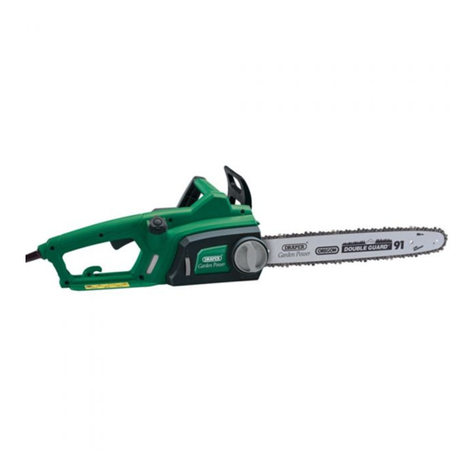
Draper
Draper CS1800A User manual
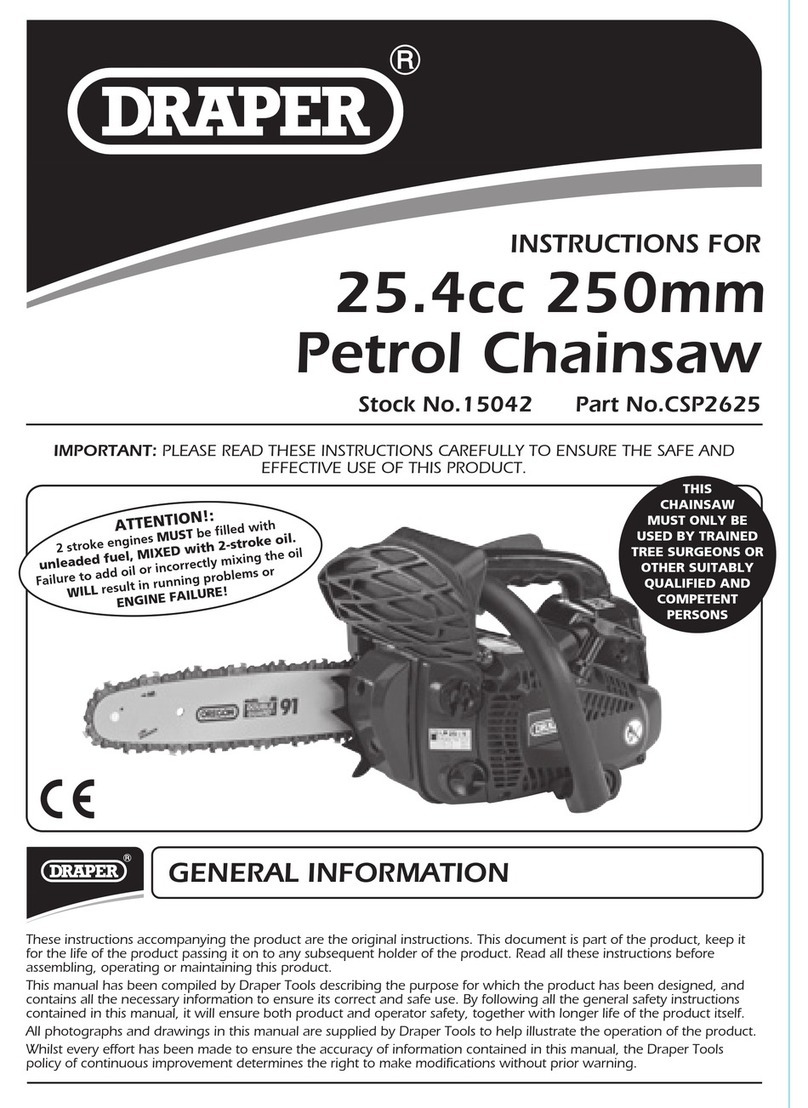
Draper
Draper CSP2625 User manual
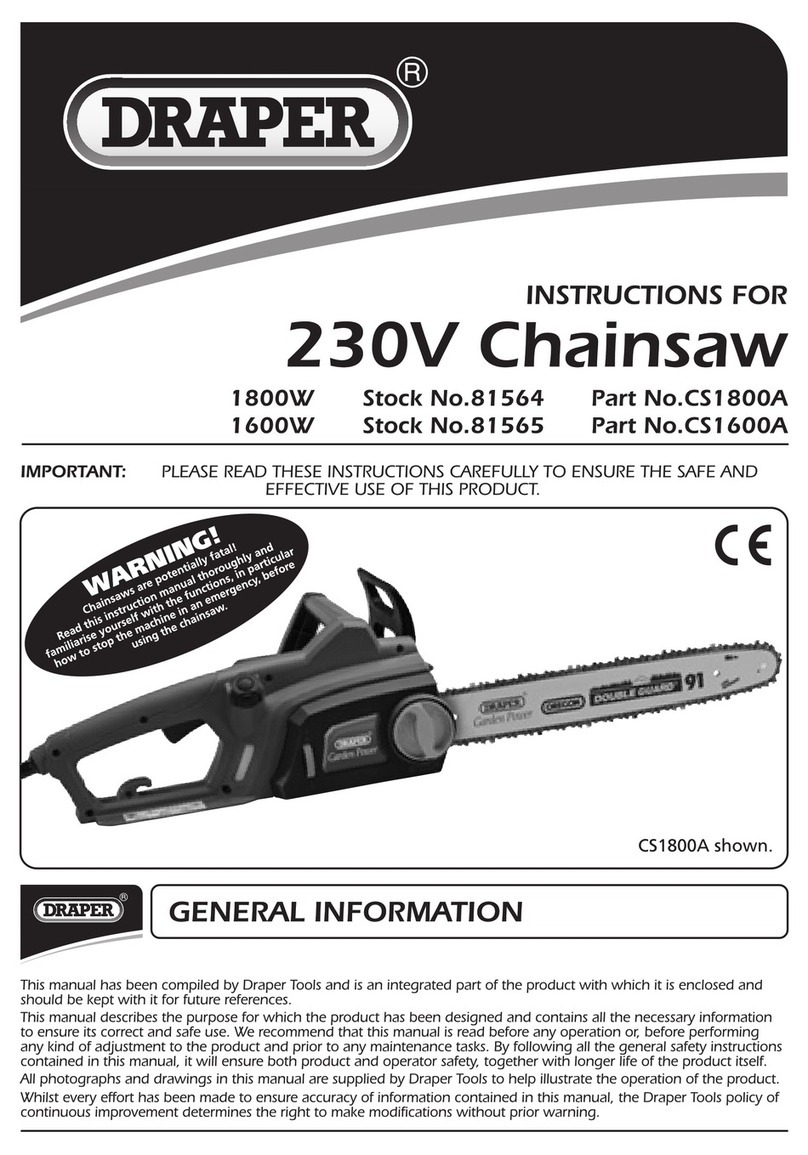
Draper
Draper CS1800A User manual

Draper
Draper CSP3740 User manual
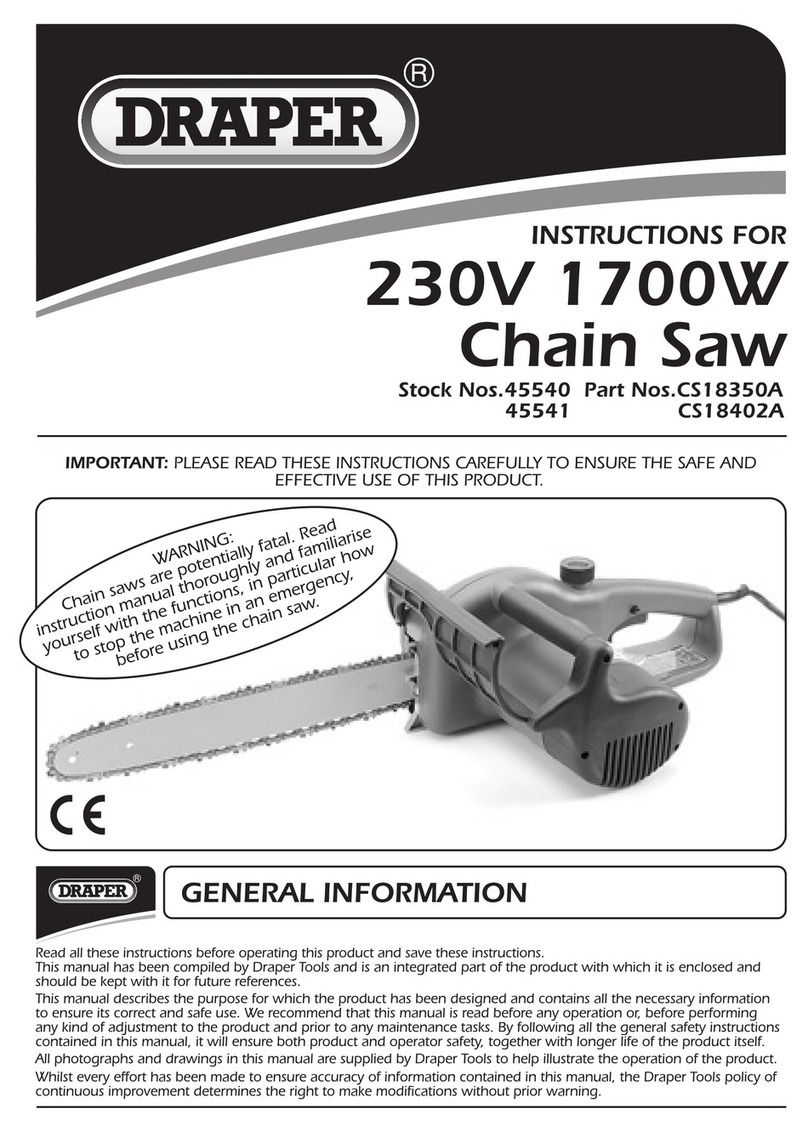
Draper
Draper CS18350A Firmware update
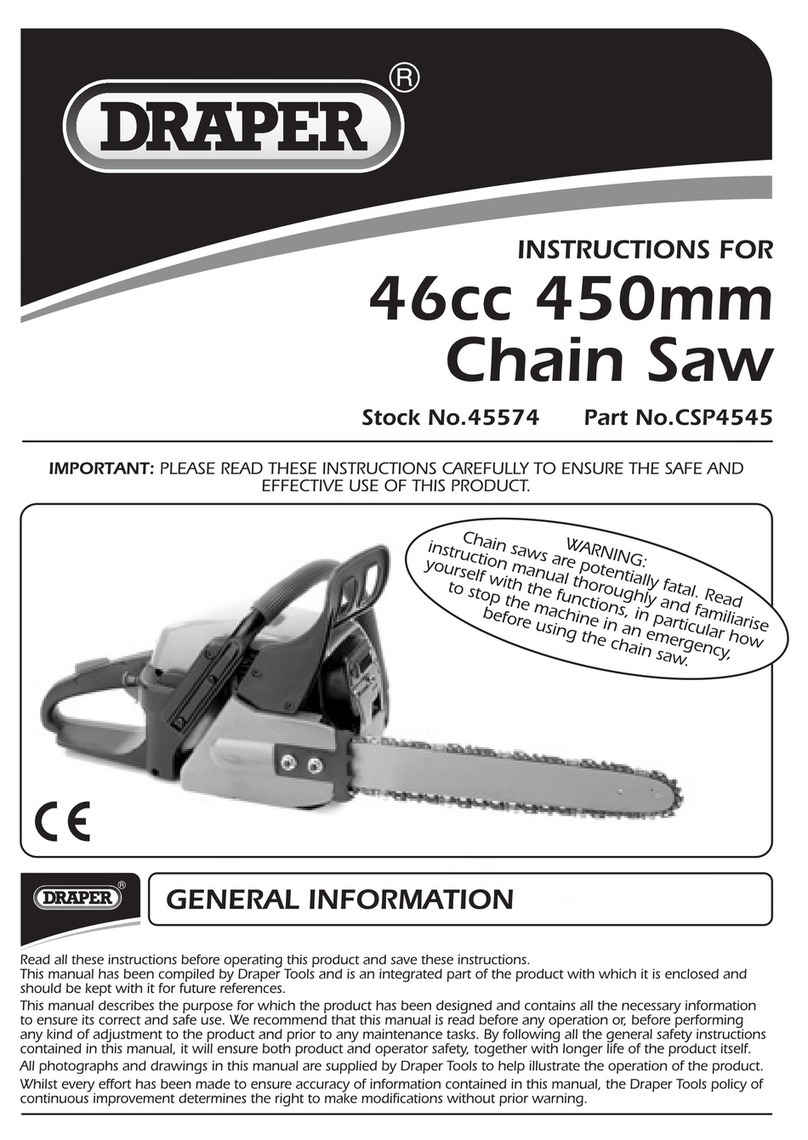
Draper
Draper CSP4545 User manual
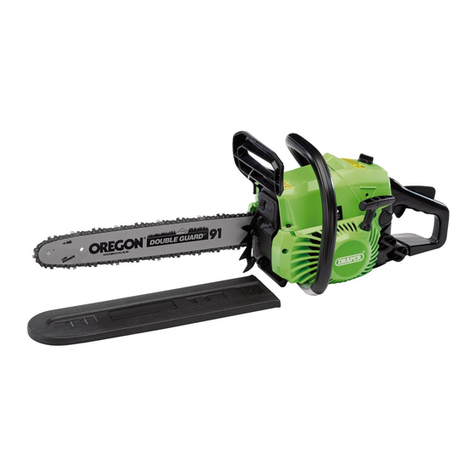
Draper
Draper CSP3940 User manual
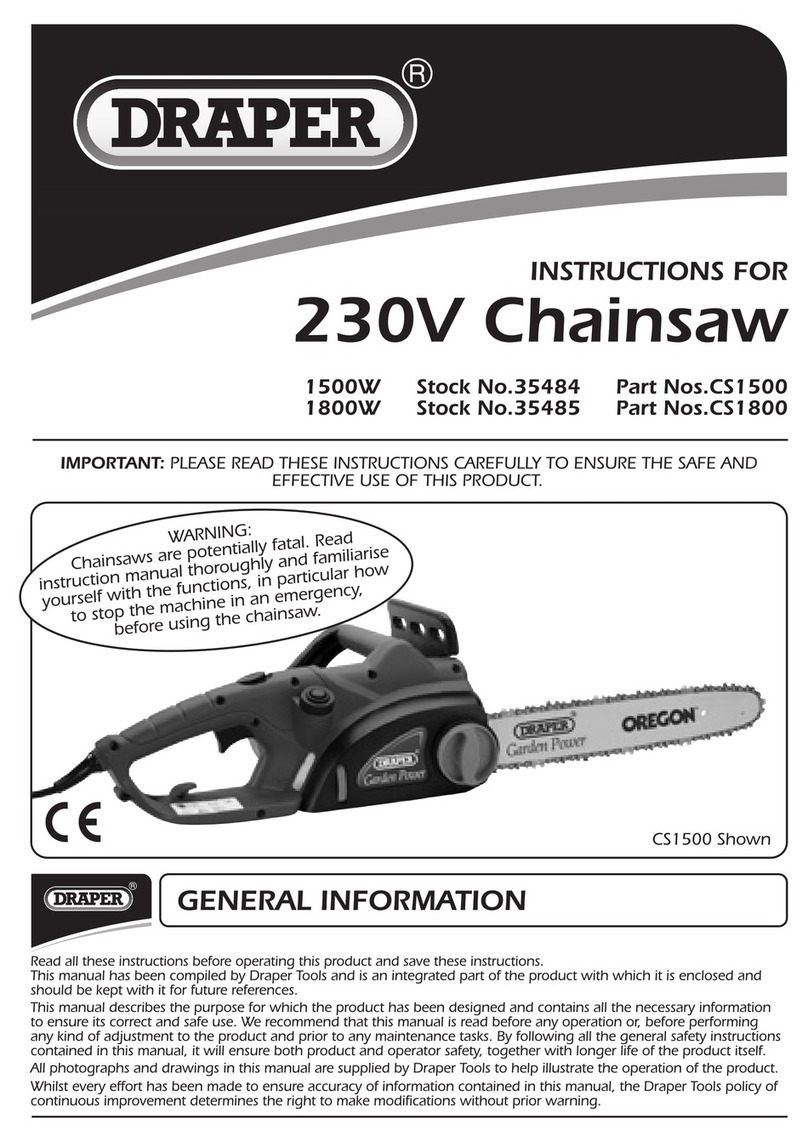
Draper
Draper c1500 User manual
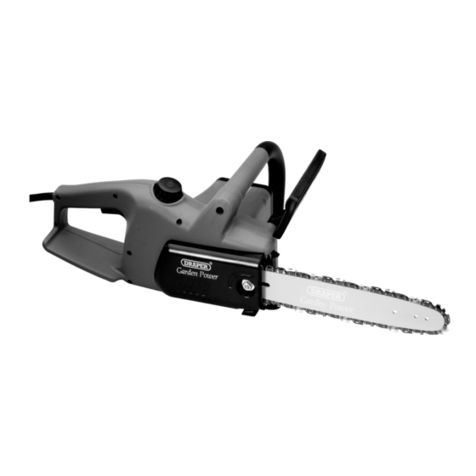
Draper
Draper CS18301 User manual
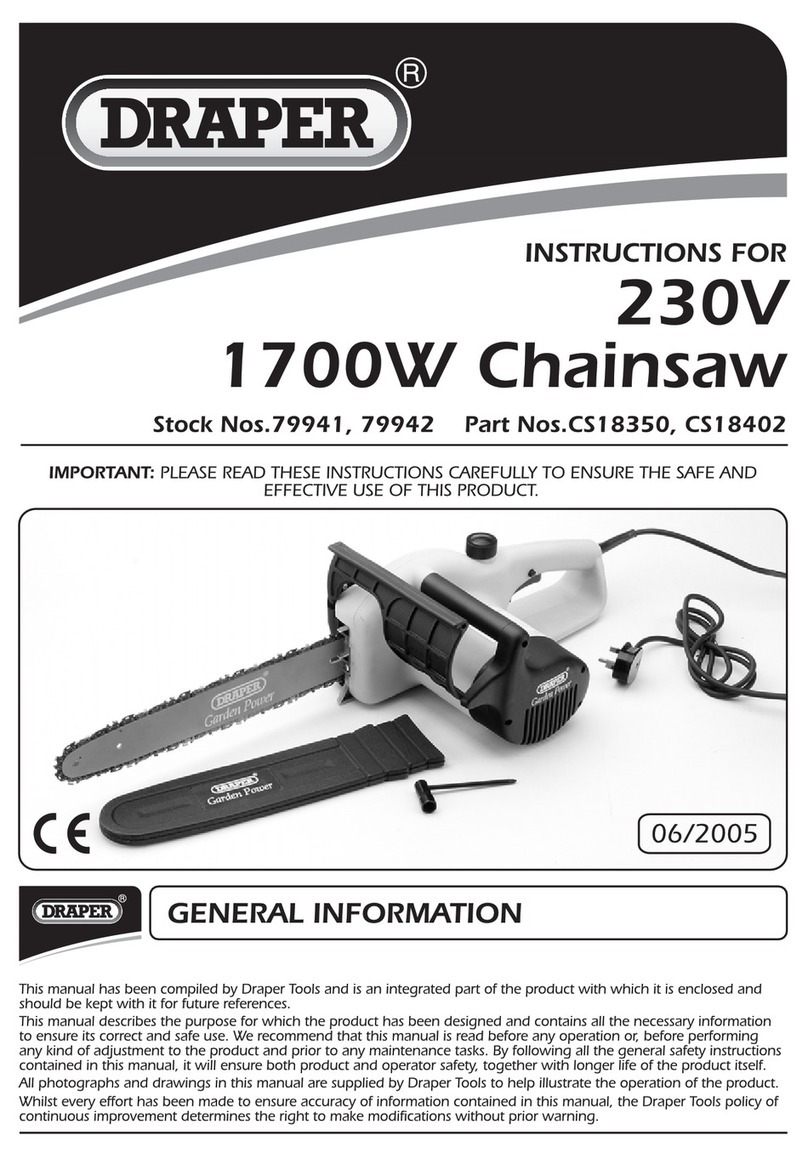
Draper
Draper 77941 User manual
Popular Chainsaw manuals by other brands
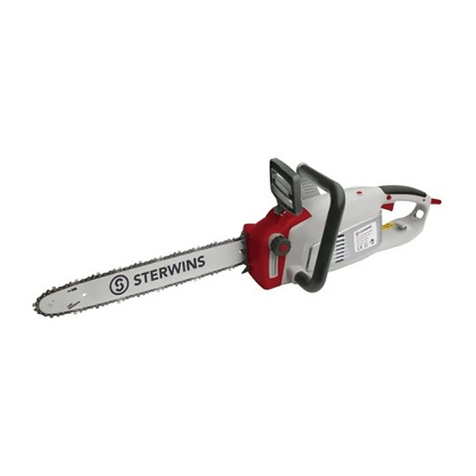
STERWINS
STERWINS 2200 CS ILM-2 Original instruction

DeWalt
DeWalt DCMCS575 Original instructions
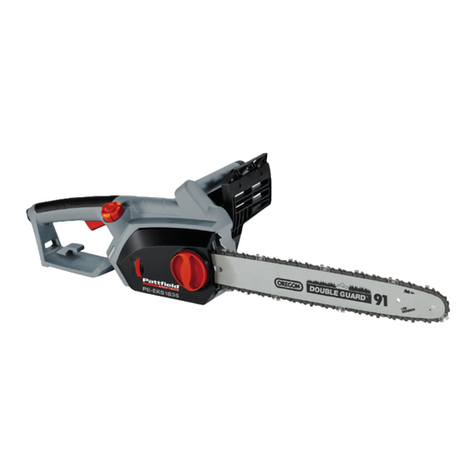
Pattfield Ergo Tools
Pattfield Ergo Tools PE-EKS 1835 Original operating instructions
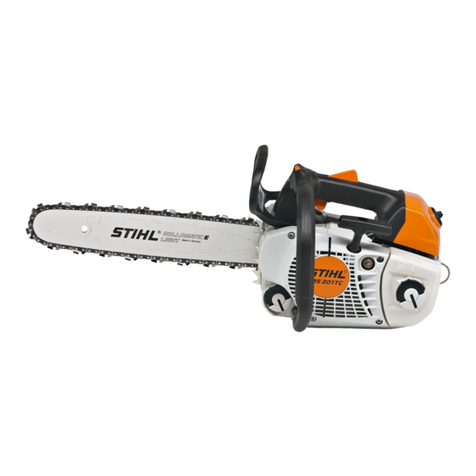
Stihl
Stihl MS 201 TC-M instruction manual
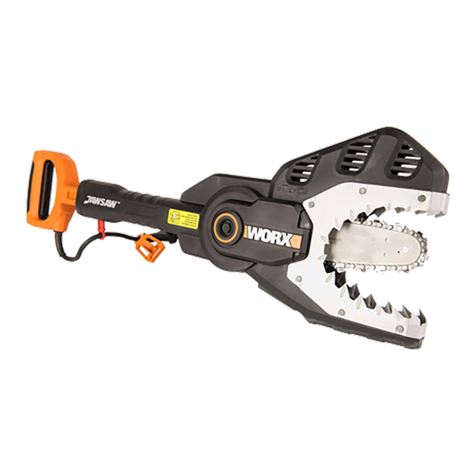
Worx
Worx Jawsaw WG307E Safety and operating manual
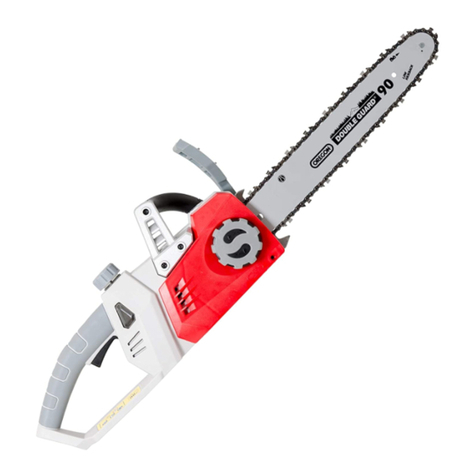
Ikra
Ikra SHES 40 operating instructions
